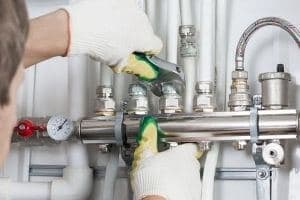Shower Plumbing: Frequently Used, but Issue Prone
Most people shower a lot. Usually at least once a day, although many people take showers multiple times in a day, and in multi-person homes, that usage is even higher. Due to this heavy use, it should be no surprise that showers can often be one of the most likely spots for plumbing issues. Below, readers can learn more about the overall plumbing system in the home, the bathroom’s plumbing and the intricacies of the shower itself.
The Overall Plumbing System

Understanding how the plumbing system works can help homeowners find and stop problems before they become serious. There are two separate parts to any system: supply and sewage. Supply lines are where pressurized water comes into a home from the city water line. The water passes through a meter and a shut-off valve (always know where the main shut off is!), then continues through smaller lines throughout the house.
Wastewater systems rely on gravity and the slope of pipes to dispose of all the water and waste used in a home. Sewage lines use traps to help prevent gasses and smells from leaking back into the house, and vents on the roof ensure proper flow and drainage. Properly done drainage systems also include cleanouts, where blockages can be removed without removing or damaging the pipes.
The connecting pieces in the plumbing system are known as fixtures; sinks, faucets and toilets are included in that term. These are where the water from supply lines gets used and drained into the sewer lines.
Your Bathroom Plumbing

Most bathrooms have three main fixtures: a toilet, a sink and a shower. They all use different amounts of water input and output to keep the home clean and sanitary. The toilet typically requires a smaller amount of cold water, but a large drainpipe.
Sinks need hot and cold lines, and the shower will need the largest lines to provide good pressure, as well as a medium-sized drain. Exactly how these are connected will depend on the bathroom, fixtures and local plumbing codes.
The Intricacies of Shower Plumbing
Shower and tub plumbing are usually one of the more complicated parts of bathroom plumbing. Temperature control is very important for showers and is usually a valve that balances the amount of hot and cold water when combined. Modern showers even have anti-scald features that help prevent aggressive temperature swings. For showers with a tub, a diverter valve must be used, which blocks the flow of water and redirects it to the other fixture present. This is true regardless of what kind of tub the shower has.

Shower pipes can be plastic or copper, depending on the age of the home. A shower drain will connect to a p-trap to prevent smells and backwash, which connects to a larger wastewater line. One thing that tends to make showers trickier to work on is that all of the plumbing is behind a waterproof barrier that must be removed to fix any issues. Since the showerhead requires a lot of pressure, the supply pipes may receive more stress than other parts of the plumbing system, requiring earlier replacement.
If homeowners suspect a leak or hear knocking noises when turning the water on or off, it’s time to call a plumber to look at the system. They will get it fixed up in no time!
About Gene Johnson Heating, Cooling, Plumbing and Electrical
Since 1976 Gene Johnson Heating, Cooling, Plumbing and Electrical has been serving the Seattle area. Now owned by the second generation of the family, they pride themselves on excellent customer service. With clear and upfront communication, they provide full services for all plumbing and heating needs.





